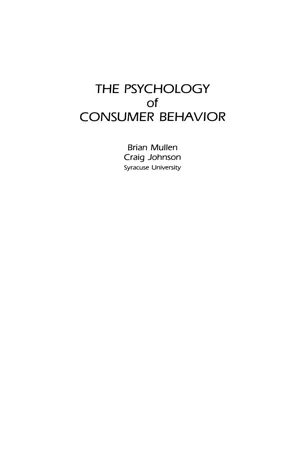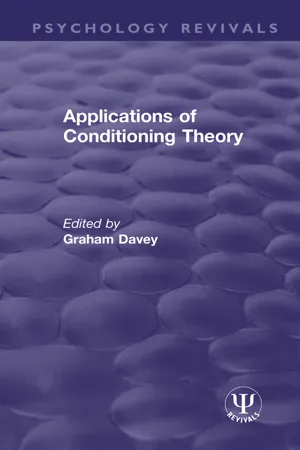Psychology
Classical Conditioning
Classical conditioning is a type of learning in which a neutral stimulus becomes associated with a meaningful stimulus and acquires the capacity to elicit a similar response. This process was first described by Ivan Pavlov in his experiments with dogs, where he demonstrated how a neutral stimulus (a bell) could come to evoke a response (salivation) after being paired with a meaningful stimulus (food).
Written by Perlego with AI-assistance
Related key terms
7 Key excerpts on "Classical Conditioning"
- eBook - ePub
- Brian Mullen, Craig Johnson(Authors)
- 2013(Publication Date)
- Psychology Press(Publisher)
In Classical Conditioning, a response (the conditioned response) comes to be evoked by a previously neutral stimulus (the conditioned stimulus) that has been repeatedly paired with a stimulus (the unconditioned stimulus) that originally elicited the response (the unconditioned response). This model of learning is sometimes referred to as Pavlovian conditioning, after the Russian physiologist Ivan Pavlov (1927) who formalized and developed this model. This model is also sometimes referred to as respondent conditioning, because it is primarily concerned with beliefs that occur in response to some preceding stimulus. Fig. 5.1 illustrates this basic associational process using the typical example of Pavlov’s dog. The presentation of meat powder (the unconditioned stimulus) naturally elicits salivation (the unconditioned response) on the part of the dog. If a bell (the conditioned stimulus) is repeatedly presented immediately before the meat powder, eventually the bell will come to elicit salivation (the conditioned response). This association will become stronger as the number of pairings of the conditioned stimulus and the unconditioned stimulus increases. Contrary to the impression sometimes conveyed in textbooks on consumer behavior (e.g., Assael, 1981), the Classical Conditioning model is a very powerful means of describing the effects that commercial advertisements can have on consumers (Bierley, McSweeney, & Van Nieuwkerk, 1985; McSweeney & Bierley, 1984; Nord & Peter, 1980). Classical Conditioning can be used to explain the development of emotional responses toward a product (see chapter 6), as well as the development of motivational tendencies toward a product (see chapter 7). One illustration of a more general application of Classical Conditioning is found in a study by Gorn (1982) - eBook - ePub
A History of Psychology
Globalization, Ideas, and Applications
- Robert B. Lawson, E. Doris Anderson, Antonio Cepeda-Benito(Authors)
- 2017(Publication Date)
- Routledge(Publisher)
psychical stimuli . Pavlov came to realize through his studies concerning the pairing of neutral stimuli with feeding that he was working with two types of salivary reflexes, both of which were caused by physiological responses of the nervous system. The foundational physiological response was the unconditioned response (UCR) caused by the natural stimulation of the oral cavity. The second reflex, conditioned responses (CR), could activate areas other than the oral cavities (i.e., eyes, ears, and/or nose; Pavlov, 1955). The next step was to explain the relationship between the two types of responses. He described the paradigm in terms of an unconditioned stimulus (US), a biological stimulus that has the capacity to elicit automatically a reflex activity that yields the UCR, whereas a conditioned stimulus (CS) is a stimulus that was at one time a neutral stimulus but through repeated pairings with the US elicits a CR similar to the UCR. This basic paradigm, as we will see, has been applied to many learning phenomena to explain phenomena such as delayed conditioning, trace conditioning, stimulus conditioning, extinction, spontaneous recovers, disinhibition, stimulus generalization, discrimination, and temperament.Applied Pavlovian Conditioning
Pavlovian conditioning or Classical Conditioning is no longer viewed strictly as the pairing of a conditioned stimulus with an unconditioned stimulus, but rather involves circumstances around the learning, that is, the context of the learning and other pertinent variables (Rescorla, 1988). An area of psychology that has undergone major changes as well as flourished as a result of the systematic application of the principles of Pavlovian conditioning is psychotherapy. In fact, the work of Rescorla (1988) and others has extended Pavlovian conditioning so that we now have a better understanding, treatment, and even prevention of pathology, especially in the areas of anxiety disorders and drug addiction.Recent theories of panic disorder (PD) with and without agoraphobia (fear of going out of the home) have been based in Classical Conditioning. Pavlovians argue that the conditioning of anxiety and/or panic to interoceptive (i.e., increased heart rate or lightheadedness) and exteroceptive (i.e., physical location) cues upon exposure to an episode of a panic attack can be understood as emotional conditioning - Nancy Fenton, Jessica Flitter(Authors)
- 2015(Publication Date)
- Research & Education Association(Publisher)
Before Classical Conditioning can occur, an unconditioned stimulus will result in an unconditioned response. This pairing provides the basis for learning through Classical Conditioning. The neutral stimulus, which will become the conditioned stimulus, is neutral at this time and does not produce any reflexive response. During the second stage, the neutral stimulus is repeatedly paired with the unconditioned stimulus until it becomes the conditioned stimulus. In the final stage of Classical Conditioning, the conditioned stimulus will produce a conditioned response without the presence of the unconditioned stimulus. The three stages of Classical Conditioning are identified and applied to Pavlov’s classic experiment in Table 8.2. Table 8.2. Three Stages of Classical Conditioning in Pavlov’s Classic Experiment During his research Ivan Pavlov discovered that the effectiveness of Classical Conditioning related to a variety of factors, including the frequency (number of times) of the pairings and the timing of when each stimulus was presented. Pavlov discovered that responses would be strengthened if the NS and UCS were paired together more often. Although there are a variety of procedures for presenting stimuli in Classical Conditioning, research has determined that introducing the NS (which will become the CS) immediately before the UCS will result in the most effective learning. In addition, the amount of time between presenting the NS and UCS is most effective if the interval is between half a second and a few seconds. Several different procedures for pairing stimuli and their application to Pavlov’s research are listed in Table 8.3. Table 8.3- eBook - ePub
- Graham Davey(Author)
- 2017(Publication Date)
- Routledge(Publisher)
6 Pavlovian principles and behaviour therapyGlyn Thomas and Mark O'CallaghanIn the early years of the present century, J.B. Watson claimed that human behaviour was nothing more than long sequences of conditioned reflexes. Fifty years on, W.F. Brewer (1974) felt able to argue that there was no convincing evidence for Classical Conditioning in adult humans.The present chapter attempts to trace the fluctuating fortunes of Pavlovian (classical) conditioning as a model for analysis and treatment in clinical settings (behaviour therapy). Firstly, we provide a brief historical survey of clinical applications of Pavlovian conditioning. Secondly, taking the treatment of fear and anxiety as an illustration, we evaluate the clinical success of these applications. Finally, we attempt to relate current practices of behaviour therapy to recent theories of Pavlovian conditioning.Historical survey
Experimentally, Pavlovian conditioning is achieved by pairing two stimuli without regard to the subject's behaviour. We can illustrate this procedure with Watson and Rayner's (1920) classic study of conditioned fear in a human infant (Little Albert). At the time of the study, Albert was eleven months old. Earlier, when he was presented with a white rat he showed no sign of fear. After seven pairings of the rat (conditioned stimulus) with a distressingly loud noise (unconditioned stimulus), Albert showed clear signs of fear when the white rat was presented alone. Watson and Rayner (1920) interpreted this result as a clear demonstration of the process by which fears of specific objects (phobias) are learned in everyday circumstances.Experiments which have attempted to repeat Watson and Rayner's demonstration have met with varying success. Whatever the status of its empirical support Watson and Rayner's study has become an influential legend in the history of clinical psychology; that the development of emotional responses can be represented in terms of Pavlovian principles. - eBook - ePub
Theories of Development
Concepts and Applications
- William Crain(Author)
- 2015(Publication Date)
- Routledge(Publisher)
Finally, after a long struggle with himself, he began studying the conditioning process. Still, Pavlov believed that he was working as a physiologist, not a psychologist. In fact, Pavlov required that everyone in his laboratory use only physiological terms. If his assistants were caught using psychological language—referring, for example, to a dog’s feelings or knowledge—they were fined (R. Watson, 1968, pp. 408–412). Basic Concepts The Classical Conditioning Paradigm. In a typical experiment (Pavlov, 1928, p. 104), a dog was placed in a restraining harness in a dark room and a light was turned on. After 30 seconds some food was placed in the dog’s mouth, eliciting the salivation reflex. This procedure was repeated several times—each time the presentation of food was paired with the light. After a while the light, which initially had no relationship to salivation, elicited the response by itself. The dog had been conditioned to respond to the light. In Pavlov’s terms (1927, lectures 2 and 3), the presentation of food was an unconditioned stimulus (US) ; Pavlov did not need to condition the animal to salivate to the food. The light, in contrast, was a conditioned stimulus (CS) ; its effect required conditioning. 1 Salivation to the food was called an unconditioned reflex (UR), and salivation to the light was called a conditioned reflex (CR). The process itself is called Classical Conditioning. You might have noticed in this experiment that the CS appeared before the US; Pavlov turned on the light before he presented the food. One of the questions he asked was whether this is the best order for establishing conditioning. He and his students discovered that it is. It is very difficult to obtain conditioning when the CS follows the US (1927, pp. 27–28). Other studies have suggested that conditioning often occurs most rapidly when the CS is presented about one-half second prior to the US (see Schwartz, 1989, p - eBook - ePub
Learning & Behavior
Eighth Edition
- James E. Mazur(Author)
- 2016(Publication Date)
- Routledge(Publisher)
Chapter 3 Basic Principles of Classical ConditioningLearning ObjectivesAfter reading this chapter, you should be able to- describe the procedure of Classical Conditioning and some of the most common ways it is studied in the laboratory
- explain Pavlov’s stimulus substitution theory, and describe its strengths and weaknesses
- describe the basic principles of Classical Conditioning, including acquisition, extinction, spontaneous recovery, conditioned inhibition, generalization, and discrimination
- explain how the timing of the stimuli in Classical Conditioning affects the results
- give examples of Classical Conditioning that are found in everyday life
- describe some behavior therapies that are based on Classical Conditioning, and evaluate their effectiveness
Pavlov’s Discovery and Its Impact
The Russian scientist Ivan Pavlov is one of the most famous figures in the history of psychology. Pavlov was interested in the various substances secreted by an animal’s digestive system to break down the food eaten, including saliva. He used dogs in his research, and he developed a surgical technique that enabled him to redirect the saliva from one of the dog’s salivary ducts through a tube and out of the mouth, so that it could be measured (see Figure 3.1 ). A dog might receive several test sessions on successive days. In each session the animal would be given food, and its salivation would be recorded as it ate. Pavlov’s important observation came when studying dogs that had been through the testing procedure several times. Unlike a new dog, an experienced one would begin to salivate even before the food was presented. Pavlov reasoned that some stimuli that always preceded the presentation of food, such as the sight of the experimenter, had developed the ability to elicit the response of salivation. Pavlov concluded that his dogs were exhibiting a simple type of learning: Salivation, which began as a reflexive response to the stimulus of food in the dog’s mouth, was now elicited by a new stimulus. This phenomenon is now known as Classical Conditioning - Steven R. Lindsay(Author)
- 2013(Publication Date)
- Wiley-Blackwell(Publisher)
pairing . After repeated pairings (although sometimes one is enough), a conditional association between the two stimuli is established, so that the previously neutral stimulus (now a CS) is capable of eliciting a CR resembling the UR that had been originally elicited only by the US. In pseudoconditioning, the stimulus (neutral) elicits a response resembling a UR, even though it has never been paired with the US.For example, if a dog receives an intense shock delivered by an electronic collar and then a few hours later a buzzer sound is delivered by the same collar, the dog may react to the sound as though it had been actually shocked rather than just buzzed. This behavioral change occurs even though the buzzer was never actually paired with shock in the past. The buzzer apparently acquires CS-like properties through sensitization and other association effects that do not strictly belong to the Classical Conditioning paradigm. In fact, any strong surprising or startling event may cause pseudoconditioning , that is, evoke responses to neutral stimuli that have never been paired with the eliciting US. Another important factor in the foregoing example is generalization —that is, the vibrating buzzer may seem similar in some particulars to shock, thus facilitating a connection between the two stimulus events. However, the similarities between the shock and buzzer sound are not the only factors involved. Although generalization is often present in pseudoconditioning, an even more important consideration is context . In the present instance, the buzzer occurs in close association with the source of electrical stimulation, with both stimuli being produced by a collar fastened around the dog’s neck.As the result of a particularly aversive event, the context in which the incident occurs may itself become conditionally linked to the aversive experience. When under the influence of a similar situation in the future, the dog may be more vigilant and alert for danger, exhibiting a much lower threshold for startle or escape behavior. Now an otherwise innocuous event may elicit a strong fear response (as occurs, by the way, in post-traumatic stress disorder and is commonly observed in abused dogs). For example, if a dog is attacked by another dog while out on a walk, on future occasions while walking in that same general vicinity at about the same time of day the dog may appear to be more cautious and defensive about its surroundings. Sounds and movements that might be ignored in other places now take on a new significance. A passing car with a loud muffler or a pile of leaves shifting abruptly in the wind might evoke a strong startle or panic reaction, even though there is no actual threat (past or present) associated with such occurrences themselves. For trainers working with emotionally motivated behavior problems (e.g., aggression, fears, or separation distress) behavioral effects associated with pseudoconditioning should be carefully assessed and taken into consideration when developing behavior modification programs.
Learn about this page
Index pages curate the most relevant extracts from our library of academic textbooks. They’ve been created using an in-house natural language model (NLM), each adding context and meaning to key research topics.






